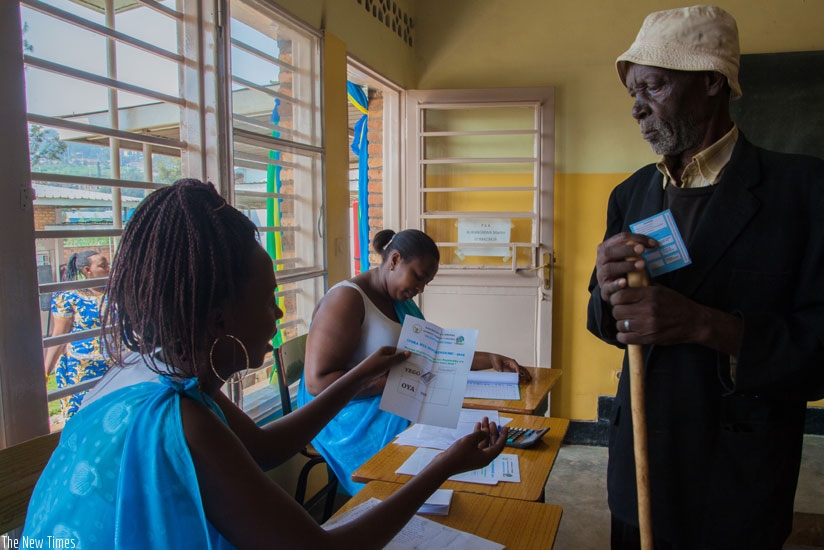An elderly voter, probably in her late 70s charged at a young polling agent at the Taba village polling station in Kicukiro District’s Niboye sector, during Friday’s historic referendum in which Rwandans emphatically voted in favour of amending the constitution.


An elderly voter, probably in her late 70s charged at a young polling agent at the Taba village polling station in Kicukiro District’s Niboye sector, during Friday’s historic referendum in which Rwandans emphatically voted in favour of amending the constitution.
"Ferundum ni inde se…inka yaduhaye ziri he? Umuntu ntora ni umwe gusa, Prezida Paul Kagame,” she said, her statement loosely translated to mean, ‘who is this Referendum chap, which cows has he given us? I only vote for one person, President Paul Kagame’.
By the end of the day’s business, all 444 members of her village who turned up for the polls, voted yes, to cap 100 percent.
Yves Ngarambe, a 28 year old motorcycle taxi operator remarked, while showing off his inked thumb after casting his vote: "Maze gutora yego, umusaza akomeze kutuyobora neza, adukorere imihanda”.
His statement, loosely translated to mean; ‘I have just voted Yes so that ‘our Mzee’ continues to govern us well and build us more roads.’ Gatebe village, his domicile, also located in Kicukiro district’s Niboye capped 100 percent after all its 505 voters ticked yes.
In the minds of many a Rwandan, Friday’s poll was about one thing; vote to keep the incumbent leader beyond this term, which expires in 2017.
However, it’s still not yet a given because the President has not given his final word on the subject.
Whatever reasons his people have to retain him, they are to do with national development whose noticeable steady progress is shared among the old and young Rwandans as seen in the case of the elderly woman and young motorcyclist of Niboye.
Long way to go
If Paul Kagame is the biblical Moses of Rwanda, then his people believe he is still energetic to lead them on for a few more miles towards the Promised Land (middle income nation with low poverty) before he can hand the reins to an Joshua.
But is he grooming an Joshua? Well, do you want to apply?
Say there’s no time for such sleazy questions; hence the dismissive answer to the foreign reporter who threw the silly question at the President, shortly after he had cast his vote, Friday morning; thing is, as long as Kagame is in-charge, there’s still plenty of work to do.
There’s, for instance, the 2015 ‘least developed countries’ report,’ by the United Nations Conference on Trade and Development (UNCTAD) launched in Kigali last week under the theme, ‘transforming rural economies’
Despite two decades of fast economic growth and development, Rwanda is still among 48 countries regarded as ‘least developed,’ a not so fancy a list to be featured and one of the ongoing government efforts is to graduate the country to middle income status by 2020.
To do that, the report recommended deliberate policies towards rural development in order to transform the lives of majority of poor people who live in rural areas.
The second Economic Development and Poverty Reduction Strategy (EDPRS2), is Rwanda’s vehicle through which it wants to achieve rural transformation and development; nonetheless, the report made similar recommendations for use by other LDCs.
Andrew Mold is an Economist with the United Nations Economic Commission for Africa (UNECA), in an interview with Sunday Times, he made sense of UNCTAD’s report and drew a link between rural transformation and poverty reduction through agricultural development.
"The poverty reduction effect of agricultural growth is 1.6 times more than that of industrial growth and three times more than that of growth in the services sector,” Mold pointed out.
Like in all the other LDCs, majority of these countries’ people live in the country side and their livelihoods directly dependent on agriculture; yet according to the report, ‘poverty rates are twice as high in rural areas as in towns and cities.’
In many cases, in a bid to escape rural poverty, many people have migrated to urban areas where they seek jobs in factories and other forms of off-farm employment. Transforming rural areas could overturn such a trend.
Vision 2020
The Promised Land, to which Rwandans want President Kagame to continue guiding them to, is explained under the country’s vision 2020 which cabinet adopted in May 2012 to guide EDPRS 2 implementation.
Among the targets is the need to accelerate economic growth with an average annual GDP expansion rate of 11.5 percent and boost per capita income to $1240.
To achieve faster growth and higher incomes, the government is targeting rapid expansion in all key sectors of the economy including agriculture which is targeted to grow at an average of 8.5 percent; industry, from current average annual growth of 8.8 percent to above 14 percent and services sector at above 13.5 percent.
Under EDPRS2, the government also wants to transform Rwanda’s economy from being rural and dependent on agriculture to being services sector driven, in pursuit of structural transformation which by 2020, Agriculture’s contribution to GDP reduced to 25 percent.
editorial@newtimes.co.rw


